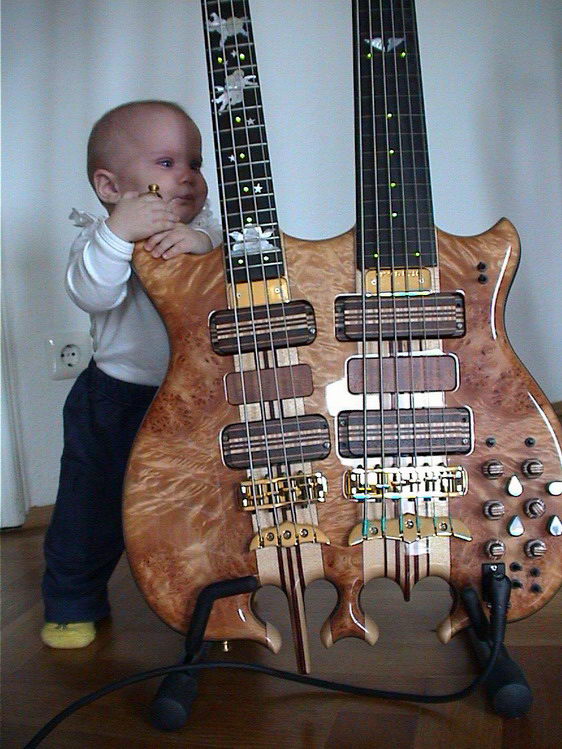Sam, that must be exciting when kids become adults. I am looking forward to that time. Meanwhile my daughter is 3 1/2 and that already is a surprisingly grown up and smart age.
Anyway: Here is another picture of her when she still was a baby:

You can also see how the bass fits on the bass stand, although it is a bit tilted in this photo.
Some more trivia about the instrument:
As great as this bass is, there are things I would do differently if I ordered this bass today:
I don't know if you realized how the cherubs and stars are positioned on the fretboard. The stars are serving as fret markers, the cherubs are filling the spaces in between. Your mind however works the other way round and wants to read the more prominent cherubs as the fret markers. That of course can result in reaching for the wrong note if you are not careful. I wanted it the other way but the LEDs couldn't be installed inside the cherubs without the danger of breaking the inlay's mother of pearl.
Another thing about the LEDs being fret markers is that I believe silver circles surrounding the LEDs is a great visual aid for the unlit LED. Unfortunately that wasn't available back when I ordered my bass.
The electronics are two independent sets of series II stereo electronics, each pickup (per neck) being output seperately. Since this bass is still using the regular 5-pin output, the two independent sets of electronics are sharing the same lines inside the cable. This is great in a way because in theory you will rarely play on both necks at the same time, so you will switch to wichever neck you want to play and still have it's two pickups coming through two seperate outputs.
However, in real life I often feel that I would prefer to use different outputs for the two different electronic sets rather than the individual pickups per one set. I would love to use one amp channel setting with the fretted sound but a different amp channel set to a customized fretless sound. Of course this would require to output both pickups per neck in mono through one line of the cable, but I must admit that I usually use my amp setup in mono anyways. Once I set up my sound on the onboard pre-amp I don't need the option to remix the pickups later again. It never really happened to me in real life. So this would be somethings I wished to change on the electronics.
Another great improvement I think, but not available when I ordered this bass, is having a pickup-blending knob combined with an overall volume knob, instead of the regular series II fashion of having two seperate pickup volume knobs. I guess I would order it like this today.
Oh, and one more thing about regular LEDs vs. laser LEDs: I always thought laser LEDs are for posers to show off in front of an audience. I changed my mind when I realized that the regular LEDs on my bass don't read very well on video and photos, which I think is a pity. After all, when I ordered this bass only red Laser LEDs were available and I wanted green. So today I would go for the green Laser-LEDs, maybe even amber ever since I saw them.
Another trivia:
Did you see the two switches at the lower horn of the corpus? Those are the switches for muting each neck. They are set up so in parallel positions always one neck is activated and the other one is muted - both up for the fretted on/frettless off and vice versa on the both-down position. With a snap of your fingers you can even mute both necks at the same time or unmute them both respectively.
There is just one issue about the location of the switches. They are so low on the corpus that when playing the bass on the lap and tilting it forward (for whatever reason) the switches can be pressed against the thigh and being forced to switch to the upper position. That can be very enoying while playing the fretless neck, I can tell you . Actually, when building this bass we thought a lot about the best location for these switches. There weren't really that many options, especially when you are thinking in terms of easy and quick access. They probably are in the best location after all. I guess it would be fun to also trigger these switches via a foot switch. No idea how this could be incorporated though. You wouldn't want a cable running down from your bass to the foot switch anyways.
One thing I am always missing is a tummy cut on the rear side of the body, something I do have on other basses and really do enjoy. It doesn't look particularly good with sandwitched wood though, the main reason why we abandoned the idea for this bass. But maybe it wouldn't look too bad after all? There is something about dented ribs I could easily live without .
Obviously there are new features available today which weren't available back then, including the inlaid logo with shell, continuous backplates, combined colors of side LEDs etc. Lots of options to choose from these days .
But let me point out some things I wouldn't ever want to miss: The Alembic Gotho mechanics are the best I have ever seen! Despite all the great things said about Schaller, the smoothness of the Gothos just feels like butter for tuning, apart from the fact that this bass doesn't detune much anyways. Not going into detail even with the rest of the great instrument...
An Alembic bass really IS a treasure.
Gee, what a lot of talking. Hope, you didn't mind.
Hartmut